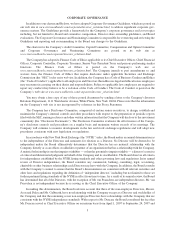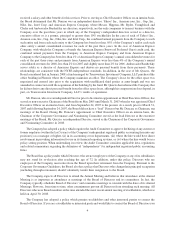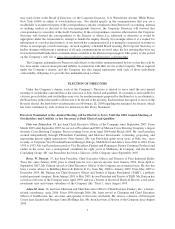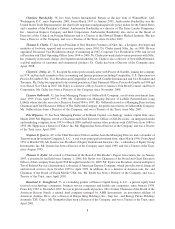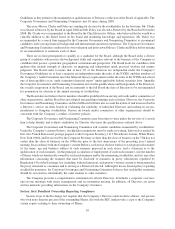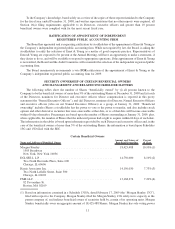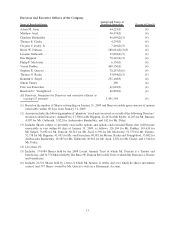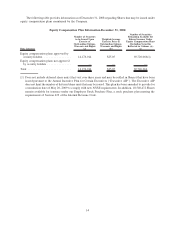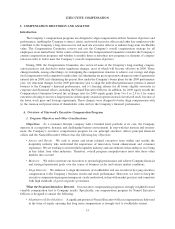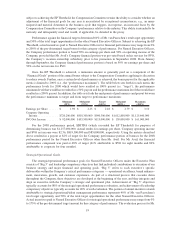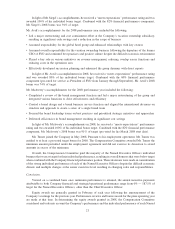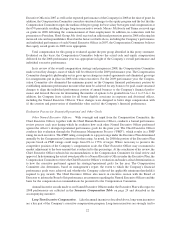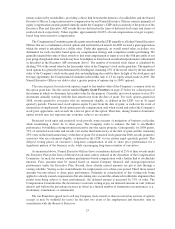Starwood 2008 Annual Report Download - page 27
Download and view the complete annual report
Please find page 27 of the 2008 Starwood annual report below. You can navigate through the pages in the report by either clicking on the pages listed below, or by using the keyword search tool below to find specific information within the annual report.EXECUTIVE COMPENSATION
I. COMPENSATION DISCUSSION AND ANALYSIS
Introduction
The Company’s compensation programs are designed to align compensation with its business objectives and
performance, enabling the Company to attract, retain, and reward executive officers and other key employees who
contribute to the Company’s long-term success and motivate executive officers to enhance long-term stockholder
value. The Compensation Committee reviews and sets the Company’s overall compensation strategy for all
employees on an annual basis. In the course of this review, the Compensation Committee considers the Company’s
current compensation programs and whether to modify them or introduce new programs or elements of compen-
sation in order to better meet the Company’s overall compensation objectives.
During 2008, the Compensation Committee also reviewed some of the Company’s long-standing compen-
sation practices and decided to make significant changes, most of which will become effective in 2009. These
changes include, among other things, (i) redesigning the compensation structure to achieve cost savings and align
total compensation with competitive market data, (ii) eliminating tax gross ups in new change in control agreements
entered into in 2008, (iii) eliminating the payout floor under the Company’s bonus plans for the 2009 performance
year, (iv) structural changes for the 2009 performance year to align the individual performance portion of annual
bonuses to the Company’s financial performance, and (v) freezing salaries for all bonus eligible associates in
corporate and divisional offices, including the Named Executive Officers. In addition, for 2009 equity awards the
Compensation Committee lowered the exchange ratio for 2009 equity grants from 3-to-1 to 2.5-to-1 for senior
executives electing to receive a larger portion of their equity awards in options instead of restricted stock, because of
the lower stock price and leverage opportunity. These changes were designed to better align compensation with
(i) the creation and preservation of shareholder value and (ii) the Company’s financial performance.
A. Overview of Starwood’s Executive Compensation Program
1. Program Objectives and Other Considerations
Objectives. As a consumer lifestyle company with a branded hotel portfolio at its core, the Company
operates in a competitive, dynamic and challenging business environment. In step with this mission and environ-
ment, the Company’s executive compensation program for our principal executive officer, principal financial
officer and the Named Executive Officers has the following key objectives:
•Attract and Retain: We seek to attract and retain talented executives from within and outside the
hospitality industry who understand the importance of innovation, brand enhancement and consumer
experience. We are working to reinvent the hospitality industry, and one element of this endeavor is to bring
in key talent from other industries. Therefore, overall program competitiveness must take these other
markets into account.
•Motivate: We seek to motivate our executives to sustain high performance and achieve Company financial
and strategic/operational goals over the course of business cycles and various market conditions.
•Align Interests: We endeavor to align the interests of stockholders and our executives by tying executive
compensation to the Company’s business results and stock performance. Moreover, we strive to keep the
executive compensation program transparent, easily understood, in line with market practices and consistent
with high standards of good corporate governance.
What the Program Intends to Reward. Our executive compensation program is strongly weighted toward
variable compensation tied to Company results. Specifically, our compensation program for Named Executive
Officers is designed to ensure the following:
•Alignment with Stockholders: A significant portion of Named Executive Officer compensation is delivered
in the form of equity, ensuring that long term compensation is strongly tied to stockholder returns.
15


